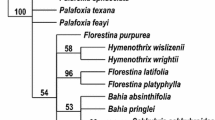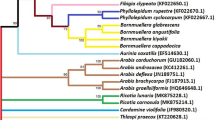Abstract
Species in the genus Castanea are widely distributed in the deciduous forests of the Northern Hemisphere from Asia to Europe and North America. They show floristic similarity but differences in chestnut blight resistance especially among eastern Asian and eastern North American species. Phylogenetic analyses were conducted in this study using sequences of three chloroplast noncoding trnT-L-F regions. The trnT-L region was found to be the most variable and informative region. The highest proportion of parsimony informative sites, more and larger indels, and higher pairwise distances between taxa were obtained at trnT-L than at the other two regions. The high A+T values (74.5%) in the Castanea trnT-L region may explain the high proportion of transversions found in this region where as comparatively lower A+T values were found in the trnL intron (68.35%) and trnL-F spacer (70.07%) with relatively balanced numbers of transitions and transversions. The genus Castanea is supported as a monophyletic clade, while the section Eucastanon is paraphyletic. C. crenata is the most basal clade and sister to the remainder of the genus. The three Chinese species of Castanea are supported as a single monophyletic clade, whose sister group contains the North American and European species. There is consistent but weak support for a sister–group relationship between the North American species and European species.


Similar content being viewed by others
References
Applequist WL, Wallace RS (2002) Deletions in the plastid trnT-trnL intergenic spacer define clades within Cactaceae subfamily Cactoideae. Plant Syst Evol 231:153–162
Bakker FT, Culham A, Gomez-Martinez R, Carvalho J, Compton J, Dawtrey R, Gibby M (2000) Patterns of nucleotide substitution in angiosperm cpDNA trnL (UAA)-trnF (GAA) regions. Mol Biol Evol 17:1146–1155
Clegg MT, Zurawaki G (1992) Chloroplast DNA and the study of plant phylogeny: present status and future prospects. In: Doyle JJ (ed) Molecular systematics of plants. Chapman & Hall, New York, pp 275–294
Cummings M, King L, Kellogg E (1994) Slipped-strand mispairing in a plastid gene: rpoC2 in grasses (Poaceae). Mol Biol Evol 11:1–8
Dane F, Hawkins LK, Huang H (1999) Genetic variation and population structure of Castanea pumila var. ozarkensis. J Am Soc Hortic Sci 124:666–670
Dane F, Lang P, Huang H, Fu Y (2003) Intercontinental genetic divergence of Castanea species in eastern Asia and eastern North America. Heredity 91:314–321
Felsenstein J (1985) Confidence limits on phylogenies: An approach using the bootstrap. Evolution 39:783–791
Fineschi S, Taurchini D, Villani F, Vendramin GG (2000) Chloroplast DNA polymorphism reveals little geographical structure in Castanea sativa mill. (Fagaceae) throughout southern European countries. Mol Ecol 9:1495–1503
Fukuda T, Yokoyama J, Ohashi H (2001) Phylogeny and biogeography of the genus Lycium (Solanaceae): inferences from chloroplast DNA sequences. Mol Phylogenet Evol 19:246–258
Graham SW, Patrick A Reeves, Analiese CE Burns, Olmstead RG (2000) Microstructural changes in noncoding chloroplast DNA: interpretation, evolution, and utility of indels and inversions in basal angiosperm phylogenetic inference. Int J Plant Sci 161:S83–S96
Graves AH (1950) Relative blight resistance in species and hybrids of Castanea. Phytopathology 49:1125–1131
Huang H, Dane F, Norton JD (1994) Allozyme diversity in Chinese, Seguin and American chestnut (Castanea spp.). Theor Appl Genet 88:981–985
Huang H, Carey WA, Dane F, Norton JD (1996) Evaluation of Chinese chestnut cultivars for resistance to Cryphonectria parasitica. Plant Dis 80:45–47
Huang H, Dane F, Kubisiak TL (1998) Allozyme and RAPD analysis of the genetic diversity and geographic variation in wild populations of the American chestnut (Fagaceae). Am J Bot 85:1013–1021
Jaynes R (1975) Chestnut. In: Moore J (ed) Advances in fruit breeding. Purdue Univ. Press, West Lafayette, pp 490–503
Johnson GP (1988) Revision of Castanea sect. Balanocastanon (Fagaceae). J Arnold Arbor 69:25–49
Kelchner SA (2000) The evolution of non-coding chloroplast DNA and its application in plant systematics. Ann Mo Bot Gard 87:482–498
Kelchner SA, Wendel JF (1996) Hairpins create minute inversions in non-coding regions of chloroplast DNA. Curr Genet 30:259–262
Kelchner SA, Clark LG (1997) Molecular evolution and phylogenetic utility of the chloroplast rpl16 intron in Chusquea and the Bambusoideae (Poaceae). Mol Phylogenet Evol 8:385–397
Kimura M (1980) A simple method for estimating evolutionary rate of base substitutions through comparative studies of nucleotide sequences. J Mol Evol 16:111–120
Lang P, Huang H (1999) Genetic diversity and geographic variation in natural populations of the endemic Castanea species in China. Acta Bot Sin 41:651–657 (in Chinese)
Levinson G, Gutman G (1987) Slipped-strand mispairing: a major mechanism for DNA sequence evolution. Mol Biol Evol 4:203–221
Manos PS, Stanford AM (2001) The historical biogeography of Fagaceae: tracking the tertiary history of temperate and subtropical forests of the Northern Hemisphere. Int J Plant Sci 162:S77–S93
Manos PS, Zhou ZK, Cannon CH (2001) Systematics of Fagaceae: phylogenetic tests of reproductive trait evolution. Int J Plant Sci 162:1361–1379
McDade LA, Moody ML (1999) Phylogenetic relationships among Acanthaceae: evidence from noncoding trnL-trnF chloroplast DNA sequences. Am J Bot 86:70–80
Morton BR (1995) Neighboring base composition and transversion/transition bias in a comparison of rice and maize chloroplast noncoding regions. Proc Natl Acad Sci USA 92:9717–9721
Nixon KC, Crepet WL (1989) Trigonobalanus (Fagaceae): taxonomic status and phylogenetic relationships. Am J Bot 6:828–841
Olmstead R, Palmer JD (1994) Chloroplast DNA systematics: a review of methods and data analysis. Am J Bot 81:1205–1224
Qui Y, Chase MW, Parks CR (1995) A chloroplast DNA phylogenetic study of the eastern Asia-eastern North America disjunct section Rytidospermum of Magnolia (Magnoliaceae). Am J Bot 82:1582–1588
Shaw J, Lickey EB, Beck JT, Farmer SB, Liu W, Miller J, Siripun KC, Winder CT, Schilling EE, Small RL (2005) The tortoise and the hare II: relative utility of 21 noncoding chloroplast DNA sequences for phylogenetic analysis. Am J Bot 92:142–166
Simmons MP, Ochotreana H (2000) Gaps as characters in sequence-based phylogenetic analyses. Syst Biol 49:369–381
Small RL, Ryburn JA, Cronn RC, Seelanan T, Wendel JF (1998) The tortoise and the hare: choosing between noncoding plastome and nuclear Adh sequences for phylogeny reconstruction in a recently diverged plant group. Am J Bot 85:1301–1315
Soltis DE, Kuzoff RK (1995) Discordance between nuclear and chloroplast phylogenies in the Heuchera group (Saxifragaceae). Evolution 49:727–742
Stanford A (1998) The biogeography and phylogeny of Castanea, Fagus, and Juglans based on matK and ITS sequence data. UNC, Chapel Hill
Swofford DL (2000) PAUP. Phylogenetic Analysis Using Parsimony. Version 4. Sinauer Associates, Sunderland, Massachusetts
Taberlet P, Gielly L, Pautou G, Bouvet J (1991) Universal primers for amplification of three non-coding regions of chloroplast DNA. Plant Mol Biol 17:1105–1109
Vijverberg K, Bachmann K (1999) Molecular evolution of a tandemly repeated trnF(GAA) gene in the chloroplast genomes of Microseris (Asteraceae) and the use of structural mutations in phylogenetic analyses. Mol Biol Evol 16:1329–1340
Villani F, Pigliucci M, Benedettelli S, Cherubini M (1991) Genetic differentiation among Turkish chestnut (Castanea sativa Mill) populations. Heredity 66:131–136
Wen J (1999) Evolution of eastern Asian and eastern North American disjunct distributions in flowering plants. Annu Rev Ecol Syst 30:421–455
Zuker M, Mathews DH, Turner DH (1999) Algorithms and thermodynamics for RNA secondary structure prediction: a practical guide in RNA biochemistry and biotechnology. NATO ASI Series, Kluwer, Boston
Acknowledgements
We thank Cliff Parks of the University of North Carolina, Sandra Anagnostakis of the Connecticut Agricultural Research Station, and Alexandru-Lucian Curtu for providing samples.
Author information
Authors and Affiliations
Corresponding author
Rights and permissions
About this article
Cite this article
Lang, P., Dane, F. & Kubisiak, T.L. Phylogeny of Castanea (Fagaceae) based on chloroplast trnT-L-F sequence data. Tree Genetics & Genomes 2, 132–139 (2006). https://doi.org/10.1007/s11295-006-0036-2
Received:
Revised:
Accepted:
Published:
Issue Date:
DOI: https://doi.org/10.1007/s11295-006-0036-2




